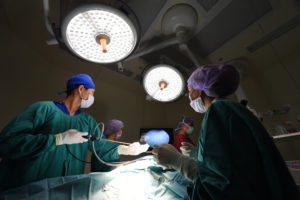
During a percutaneous nephrolithotomy, a one-centimeter incision is made over the flank area and a miniature fiber optic camera and other small instruments are threaded in through the incision. Photo: Shutterstock
There are some stones that are just too big, aren’t accessible by a ureteroscopy procedure or do not respond to shockwave lithotripsy. These may need to be treated with a procedure called a percutaneous nephrolithotomy or percutaneous nephrolithotripsy, which are just fancy names for laparoscopic surgery to remove kidney stones.
Like any laparoscopic procedure, this surgery is performed with miniature instruments and leaves minimal scarring.
Unlike the kidney stone treatments I’ve discussed before, the percutaneous nephrolithotomy is an inpatient procedure and you can expect to be in the hospital for two to three days.
The percutaneous nephrolithotomy procedure
This surgery is done under general anesthesia. A one-centimeter incision is made over your flank area and a miniature fiber optic camera called a nephroscope and other small instruments are threaded in through the incision.
If it is needed, high-frequency ultrasound is used to break up the stone. A vacuum is used to eliminate the stone if it’s turned to dust. If the removal of the stone as a whole is successful, the procedure is called a nephrolithotomy, but if the stone is first broken up and then removed, the procedure is called a nephrolithotripsy.
Once the procedure is complete, you may have a drainage (nephrostomy) tube coming out of your back. It is used to drain urine directly from the treated kidney into a drainage bag. A urinary catheter will be placed to drain the urine from your other kidney.
What to expect after the procedure
You’ll be monitored in the recovery room to ensure you have no signs of complications and that your vital signs are within the normal range. You will be sleepy as the anesthesia wears off. Sometimes anesthesia causes nausea, and if that’s the case for you, you’ll be given medication to treat it. Once you’re fully awake, you’ll be transferred to your hospital room.
You may experience post-operative pain around your kidney for a few days after the percutaneous nephrolithotomy, which can be controlled with medication. You may also have an IV in place for several hours to give you necessary fluids and pain medication.
You will receive support to begin walking before being discharged home. Walking can prevent blood clots, so it’s best to walk as much as you can tolerate.
Most nephrostomy tubes are removed within 24 to 48 hours but can remain for up to two weeks if your doctor feels it is necessary. You may also have a ureteral stent placed to drain urine from the kidney to the bladder.
Before you leave the hospital, the urinary catheter will be removed and you will be prescribed pain medication. Once you have used the last of the pain medication, you’ll be advised to switch to extra-strength Tylenol.
You may take a shower, but not a bath. Be sure to clean the area around the nephrostomy tube insertion site with soap and water and pat dry then clean with hydrogen peroxide and a cotton swab before applying a clean bandage. Fatigue may continue for up to a month after surgery.
Risks of percutaneous nephrolithotomy
Both the percutaneous nephrolithotomy and the percutaneous nephrolithotripsy have the highest success rates of removing kidney stones, but like any invasive procedure, even a minimally invasive one, there are a few potential risks, including infection, bleeding, transfusion, embolization of the kidney if an artery is inadvertently injured, and other complications. The incision in your kidney will typically heal on its own, but there are risks of injury to your other nearby organs, including the bowel, ureter, liver, or bladder.
These surgeries are not common, and not every urologist is capable of doing them well. The goal for you, as a patient, is to try to minimize the number of procedures you have, so talk to the doctors and find out what your options are.
When to call the doctor
Although the vast majority of percutaneous nephrolithotomy surgeries go well, there are some things to watch out for. If you experience any of these symptoms, call your doctor right away:
- Pain that intensifies, even after taking pain medication
- Urine with multiple blood clots in it
- Fever and chills
- Nausea and vomiting
- Chest pain
- Difficulty breathing
- Pus around the nephrostomy tube insertion site
- Your catheter stops draining or leaking around the tube.
Want to get the full scoop on percutaneous nephrolithotomy and other procedures used to treat kidney stones? Pick up a copy of my book, Even Urologists Get Kidney Stones, for some solid tips on kidney stone risks, diagnosis, treatment, and prevention.
